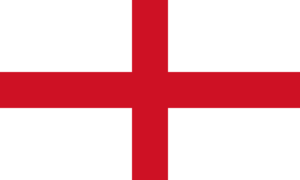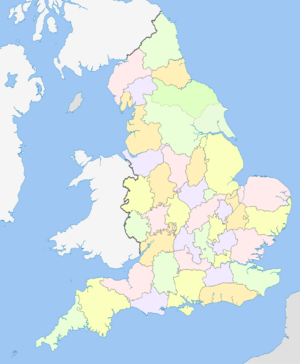- Profile
- Images
Location: England
Surnames/tags: england categorization
This is an Appendix to the Page: English Place Name Categories
It gives further guidance on categorisation issues for places in England. The guidance applies to category pages, not to individual profiles. It is intended to be used by members who are familiar with both categorisation and English geography. If in doubt, seek help from the England Project Counties Team.
Contents |
Boundary Changes
A typical Category Information Box (CIB) for an English place is constructed like this:
- CategoryInfoBox Location
- |parent= Derbyshire
- |project= England
- |team= Derbyshire
- |wikidataID= Q7107154
- |coordinate= 52.8977, -1.45886
- |webpage= http://www.visionofbritain.org.uk/place/21042
- |webpagetext= Vision of Britain
- CategoryInfoBox Location
This puts the place into its county "parent" category, in this case Derbyshire. We use the historic counties of England to name and categorise places, using this definition: The Historic Counties Standard.
Where boundary changes have taken place, people may have difficulty finding a place which is no longer in its historic county. Most online maps and current gazetteers use the current ceremonial counties, and these may be more familiar than the historic counties, particularly to younger people. The Cemeterist Project (see below) requires the use of current counties. This can be addressed in the CIB by introducing the line
- |parent1=(current county)
For example, Category:Bournemouth, Hampshire appears in the list of places in both Hampshire and Dorset, its current county.
Where a boundary change has taken place, the category page should include a brief explanatory note giving the date the change occurred.
Isle of Wight
The Isle of Wight is an exception to the general rule on using historic counties. Historically, the Isle of Wight was part of Hampshire; it became a separate administrative county in 1890, but remained in Hampshire for ceremonial purposes until 1974. However, on WikiTree we use "Place, Isle of Wight" for category names, for clarity. In the CIB:
- |parent=Isle of Wight
- |parent1=Hampshire
Isle of Wight locations, such as Category:Cowes, Isle of Wight, are thus listed on the Hampshire category page as well as on the Isle of Wight category page.
Yorkshire
Yorkshire, England's largest historic county, presents particular challenges. It was traditionally divided into three Ridings (and the City and Ainsty of York), but these are seldom used in genealogical sources. It is currently divided into four ceremonial counties, and parts of the historic county have been transferred to four others. People may wish to search for a place simply as "Place, Yorkshire", or they may know either its Riding or its current county, or both. This can be addressed in the CIB using the lines
- |parent1=(current county)
- |parent2=(Riding)
For example, Category:Bashall Eaves, Yorkshire appears in the list of places in Yorkshire; in Lancashire, its current county; and in the historic West Riding of Yorkshire.
London
London has expanded from the historic City of London into the neighbouring counties of Middlesex, Surrey, Kent, Essex and Hertfordshire. Guidance on how to categorise places in Greater London is here: Categorisation in London.
Cemeteries
Cemeteries are the main exception to the general rule to use historic counties. Cemeteries should be identified using their current location, including the current county. Where boundary changes have occurred in modern times, this might not be the same as the historic county.
Cemeteries should have two parent categories:
- County, Cemeteries, where county is the current ceremonial county; and
- Place, County in the usual way as set out in English Place Name Categories, where county is the historic county.
Guidance on how to name and set up new cemetery categories is given on this page: Space:Categorisation_in_England#Cemeteries.
Religious Congregations
Churches, chapels and other places of worship are categorised as "Religious Congregations". The Category Information Box for Religious Congregations is described on this page: CIB for Congregations.
When setting up new categories for religious congregations in England, please check that the congregation name is correct and unambiguous: it must include the word "Church", "Chapel" or similar, to distinguish it from any place or other institution with the same name; and it must include the county. "Saint" in a church name should always be abbreviated to "St" (no full stop in English usage), except in the phrase All Saints.
The key parameters in the CIB are:
- parent= This is the historic county as used for place categories. It automatically puts the congregation into the appropriate "County, Religious Congregations" parent category - there is no need to add "Religious Congregations" to the county name. Exceptions have been made for the Leeds area and Bristol: see below.
- location= This is in the usual "Place, County" format using the historic county, e.g., "Birmingham, Warwickshire". This automatically places the cemetery into the appropriate "Category:Place, County" parent category.
- cemetery= This is the category name of the associated graveyard, if appropriate.
- wikidataID=
- coordinate= latitude and longitude in decimal format, e.g., "52.5265230, -1.8827870"
Leeds, Yorkshire
Religious Congregations in the metropolitan area of the City of Leeds have a parent category of Category:Leeds, Yorkshire, Religious Congregations. This is a sub-category of Category:Yorkshire, Religious Congregations. In the CIB, parent= "Leeds, Yorkshire", rather than simply "Yorkshire".
Bristol
Religious Congregations in the City and County of Bristol have a parent category of Category:Bristol, Religious Congregations. In the CIB, "parent=Bristol". This is a sub-category of both Category:Gloucestershire, Religious Congregations and Category:Somerset, Religious Congregations.
- Login to request to the join the Trusted List so that you can edit and add images.
- Private Messages: Contact the Profile Managers privately: Stephen Heathcote, Elizabeth Viney, England Project WikiTree, and Neil Perry. (Best when privacy is an issue.)
- Public Comments: Login to post. (Best for messages specifically directed to those editing this profile. Limit 20 per day.)
- Public Q&A: These will appear above and in the Genealogist-to-Genealogist (G2G) Forum. (Best for anything directed to the wider genealogy community.)


